The Importance of Fibre for Bodybuilders
The importance of fibre as an essential nutrient is often overlooked and the daily requirements of obtaining enough presents a ...

The importance of fibre as an essential nutrient is often overlooked and the daily requirements of obtaining enough presents a ...
The old saying, "eat less move more", can actually be a GREAT way to end up 'skinny-fat! If your goal ...
Training arms is so important to the common bodybuilder or fitness enthusiast that there is absolutely no shortage of information ...
We’ve all been there. You’re in the gym busting your ass everyday, your diet is on point and you’re making ...
You have also likely heard of ‘HMB’ which is a derivative of leucine. In fact the above pathway requires that ...
What foods have resistant starch? There are 4 types of RS (resistant starch). Unlike most other ingredients, resistant starches are ...
By Roland Pankewich If you have read the first installment (Read Part 1 Here) you were introduced to the idea ...
By Roland Pankewich Read Part 1 HERE Read Part 2 HERE So far we have outlined some basic principles that ...
What if I told you that most exercise does not cause long term weight loss? This is a secret the ...
Just because that insane workout technique sounds excruciatingly awesome, that doesn't mean you should add it into your routine. You ...
Key Point Summary: – There are 5 ‘levels’, or stages, you must implement IN ORDER to optimize fat loss. – ...
Of the major neurotransmitters, acetylcholine just might be the most important from a muscle building standpoint. As a major neurotransmitter ...
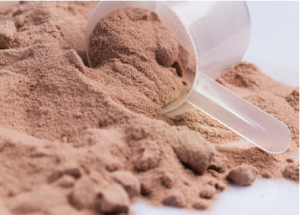 Whey protein has been used in one form or another for at least 300 years, yet it has taken until the 21st Century for it to come into its own as the superior natural sports performance supplement for hard-training athletes. From nursery rhyme characters to Mr. Olympia champions, whey protein has been employed by many to good effect. Whether sitting on tuffets and running from spiders, or squatting 600lbs while yelling “yeah buddy, light weight!”, whey can be enlisted to get the job done.
Whey protein has been used in one form or another for at least 300 years, yet it has taken until the 21st Century for it to come into its own as the superior natural sports performance supplement for hard-training athletes. From nursery rhyme characters to Mr. Olympia champions, whey protein has been employed by many to good effect. Whether sitting on tuffets and running from spiders, or squatting 600lbs while yelling “yeah buddy, light weight!”, whey can be enlisted to get the job done.
It is from the manufacturing of a product that most bodybuilders are taught to avoid (cheese) that w hey is produced. One of two main milk proteins (the other being casein, the lumpy leftovers of cheese production, otherwise known s curds),whey (occasionally known as lactalbumin, or milk plasma), the liquid portion of this production process, is often considered to be one of the most nutritious source of protein available today. Originally, whey was disposed of as waste before first going on to be used as an additive in processed goods to improve consistency. Today, whey is treated as a valuable nutritional commodity, its production and refinement a multimillion-dollar enterp
hey is produced. One of two main milk proteins (the other being casein, the lumpy leftovers of cheese production, otherwise known s curds),whey (occasionally known as lactalbumin, or milk plasma), the liquid portion of this production process, is often considered to be one of the most nutritious source of protein available today. Originally, whey was disposed of as waste before first going on to be used as an additive in processed goods to improve consistency. Today, whey is treated as a valuable nutritional commodity, its production and refinement a multimillion-dollar enterp
rise.
Though a staple dietary component for individuals who require ultra-pure protein, whey has also found a sizable home among bodybuilders seeking to optimize the building of lean muscle tissue. Whey is often viewed as mandatory among strength training athletes and bodybuilders due to the higher levels of protein required to ensure that the muscle microtrauma weightlifting incurs is duly addressed. It’s often recommended that to sufficiently advance the muscle growth process, a minimum of one gram of protein per pound of bodyweight per day is needed. Serious bodybuilders and all other high performance athletes whose sporting success depends on muscle and strength must strive achieve a sufficient daily protein intake. However, the protein these elite athletes feast upon must meet the highest possible standards for quality and bioavailability. Just as putting low octane fuel in your Maserati will invariably result in poor performance, consuming inferior protein will seriously impede your efforts in the gym and your ability to recover thereafter. Thus, bodybuilders with high standards and a commitment to excellence have for decades preferentially used whey protein in conjunction with a balanced diet to fuel their muscle building efforts.
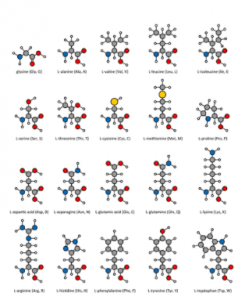 Consisting of high levels of all of the essential amino acids (which must be obtained in the diet as the body cannot manufacture them), all non-essential aminos, and an optimal ratio of the branched-chain amino acids (which comprise 35% of all amino acids found in muscle tissue and are critical for muscle repair), whey has been shown to build quality mass, and ‘possibly’ even faster than all other protein sources if some sources are to be believed. Additionally, of all the common proteins, whey contains higher levels of cysteine, an amino acid which facilitates the biosynthesis of glutathione, an important antioxidant and liver detoxifier which also helps to prevent muscle damage at the cellular level.
Consisting of high levels of all of the essential amino acids (which must be obtained in the diet as the body cannot manufacture them), all non-essential aminos, and an optimal ratio of the branched-chain amino acids (which comprise 35% of all amino acids found in muscle tissue and are critical for muscle repair), whey has been shown to build quality mass, and ‘possibly’ even faster than all other protein sources if some sources are to be believed. Additionally, of all the common proteins, whey contains higher levels of cysteine, an amino acid which facilitates the biosynthesis of glutathione, an important antioxidant and liver detoxifier which also helps to prevent muscle damage at the cellular level.
Faster Absorption and Superior Bioavailability
Serious bodybuilders and strength athletes require a reliable protein source that can be rapidly assimilated at key intervals. Because of whey protein’s ability to be absorbed completely and efficiently, less is wasted; thus, more aminos can reach the muscles to promote steady growth and strength gains. Of the wide range of unique protein sources utilized by muscle-hungry bodybuilders, whey consistently ranks highest for its digestibility and utilization. With a net protein utilization of 92% (the percentage of protein retained by the body after digestion) whey trumps the traditionally touted egg protein, which ranks second at 88%.
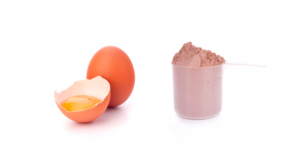 Besides scoring highest on the NPU scale, wheyalso has a superior Protein Efficiency Ratio (PER) and Biological Value (BV); the rate at which an individual protein can sustain growth and the percentage of a protein that is absorbed and utilized, respectively. With a BV of 159 whey protein isolate demolishes the biological value of eggs (100) and chicken (79), and with an impressive PER of 3.9, by comparison to eggs (3.1) and chicken (2.7), whey again comes out on top. Whey’s superiority as the perfect protein source for muscle repair and growth is not broscience: it’s real science.
Besides scoring highest on the NPU scale, wheyalso has a superior Protein Efficiency Ratio (PER) and Biological Value (BV); the rate at which an individual protein can sustain growth and the percentage of a protein that is absorbed and utilized, respectively. With a BV of 159 whey protein isolate demolishes the biological value of eggs (100) and chicken (79), and with an impressive PER of 3.9, by comparison to eggs (3.1) and chicken (2.7), whey again comes out on top. Whey’s superiority as the perfect protein source for muscle repair and growth is not broscience: it’s real science.
Additional Benefits
In addition to its clear muscle building advantages, whey protein, which is comprised of alpha-lactalbumin, beta-lactoglobulin, bovine serum albumin (BSA), immunoglobulins (IgG1, IgG2, and secretory IgA and IgM), and smaller components including iron binding proteins (lactoferrin, lactoferricin), calcium, potassium, sodium, phosphorus, vitamins A, C, B1, B2, B3, B5, B12, folic acid and biotin, possesses many additional health benefits.
Prevents muscle wasting
Whether sedentary or committed to daily exercise, aging individuals will experience a gradual reduction in muscle mass and strength. To counter such muscle wasting (called sarcopenia), older populations are urged by some to consume a diet rich in whey protein. Containing high levels of the most metabolically active branched chain amino acid leucine, which encourages muscle protein synthesis by activating a signaling-pathway in muscle that increases anabolism, whey is an especially useful protein source for those wishing to avoid sarcopenia.
 Since muscle becomes exponentially more resistant to leucine stimulation with age, muscle stores of this valuable amino acid gradually decline and, as a consequence, building muscle becomes a near impossible task. With whey’s superior absorption and utilization, leucine desensitization can be overcome and muscle mass increases can be achieved. Furthermore, the alpha-lactalbumin (alpha-lac) fraction, which comprises 15-25% of whey, and is rich in the amino acids lysine, leucine, threonine, tryptophan, and cysteine, is often specifically given to individuals with certain conditions and digestive problems which prevent the consumption of a normal diet. Alpha-lac may also have anti-cancer properties and provides immune system benefits, largely due to the high concentration of glutathione that is produced from the amino acids found in whey.
Since muscle becomes exponentially more resistant to leucine stimulation with age, muscle stores of this valuable amino acid gradually decline and, as a consequence, building muscle becomes a near impossible task. With whey’s superior absorption and utilization, leucine desensitization can be overcome and muscle mass increases can be achieved. Furthermore, the alpha-lactalbumin (alpha-lac) fraction, which comprises 15-25% of whey, and is rich in the amino acids lysine, leucine, threonine, tryptophan, and cysteine, is often specifically given to individuals with certain conditions and digestive problems which prevent the consumption of a normal diet. Alpha-lac may also have anti-cancer properties and provides immune system benefits, largely due to the high concentration of glutathione that is produced from the amino acids found in whey.
For all populations, due to its aspartic acid concentration, whey may offset fatigue by increasing stamina. Aspartic acid also has been shown to aid RNA/DNA synthesis, making whey effective for wound healing and the rebuilding of all bodily tissues. Furthermore, the aminos methionine and lysine found in whey specifically work to aid digestion, burn fat, and help maintain a positive nitrogen balance.
Reduces cognitive decline and helps cope with stress
The dietary consumption of the amino acid tryptophan is known to relieve depression and stress due to its ability to synthesize the brain’s feel good, cognition-enhancing neurotransmitter serotonin, which is known to decline with age.
Furthermore, one study found that the alpha-lactalbumin in whey protein increased plasma levels of tryptophan, and subsequently improved mood and coping ability in subjects assessed as highly vulnerable to stress. Because memory can decline under stress, the alpha-lactalbumin component of whey (along with its ability to boost glutathione) may help to restore cognitive decline in susceptible populations.
Promotes fat loss
Whey protein has for decades been touted as the superior supplement for fat loss in addition to muscle building, and for good reason. Firstly, its ability to suppress appetite. With a 15-20% composition of glycomacropeptides (a small protein molecule linked to a sugar molecule), whey stimulates the synthesis and release of cholecystokinin, a peptide hormone of the gastrointestinal system which informs our brain when we have eaten enough. Thus whey is exceptional among all other protein sources in its specific appetite suppressant effect. Further, in general, whey is also considered a superior nutritional means to boosting metabolic efficiency, thereby increasing the extent to which we burn fat at rest.
May help prevent type 2 diabetes
Whey protein has been shown to have beneficial insulinotropic and glucose lowering properties both of which help stabilize blood sugar and slow the release of glucose into the bloodstream. Upon their digestion, the combination of unique bioactive peptides and amino acids found in whey encourage the release of gut hormones such as cholecystokinin, peptide YY, and glucagon-like peptide 1, which act in concert to potentiate insulin secretion and regulate blood sugar, making whey an excellent protein alternative for those watching their weight and wishing to remain diabetes free. A report published in the American Journal of Clinical Nutrition also determined consuming whey protein before a meal to be an effective strategy for lowering post-meal blood glucose and insulin levels.
Boosts immune function
Whey protein is known for its ability to strengthen the immune system due to its high concentration of cysteine, an amino acid instrumental in synthesizing the important antioxidant glutathione (GSH). Glutathione levels have been shown to decrease following intensive exercise, which may lead to a greater susceptibility among hard training athletes to contract colds and other illnesses. It is believed that the immune system works best if the lymphoid cells (immune  cells which include natural killer cells) have a delicately balanced intermediate level of GSH. In one study, researchers found that by treating prostate cells with hydrolyzed whey protein isolate (WPI), intracellular GSH levels were increased by 64%, which protected these cells against oxidant-induced cell death compared to controls. GSH also works to eliminate many carcinogens while boosting immune function and bolstering the body’s anti-tumor defenses.
cells which include natural killer cells) have a delicately balanced intermediate level of GSH. In one study, researchers found that by treating prostate cells with hydrolyzed whey protein isolate (WPI), intracellular GSH levels were increased by 64%, which protected these cells against oxidant-induced cell death compared to controls. GSH also works to eliminate many carcinogens while boosting immune function and bolstering the body’s anti-tumor defenses.
Additionally, the high levels of lactoferrin found in whey, a multifunctional protein with iron-binding and immune-enhancing properties, also reinforces immune system integrity. To help confirm whey’s immunity fortifying functions, researchers divided 387 U.S. Marines into three groups, with each group taking whey protein, a carbohydrate/fat supplement, or a placebo over 54 days. It was subsequently found that the whey protein group showed a stronger immune system with 33% fewer medical visits and 28 fewer visits for muscle and joint problems compared to the other groups.
Finally, the bovine serum albumin (BSA) fraction which comprises 2-5% of whey, increases the production of infection-fighting white blood cells, called T-cells, and also increases antioxidant activity in the body.
Protects gastrointestinal tissue and increases beneficial bacteria
Whey protein promotes a healthy gut in several ways. First, because whey boosts glutathione levels it helps to reduce bowel inflammation; second, whey provides glutamine (around 6g per 100g of whey), the preferred fuel source of the epithelial cells which line the small intestine. Thirdly, whey’s alpha-lactalbumin fraction protects against gastric injury caused by stress.
Potential Whey Downsides
Weak bones
While it is true that hard-training athletes have higher protein requirements than sedentary individuals, and whey protein can be an excellent way to meet those extra needs, medical authorities have suggested that an overabundance of protein may increase the likelihood of calcium loss and osteoporosis. Whenever protein is digested, acids are released into the bloodstream that need to be neutralized, and calcium is what our bodies use to neutralize these acids. If protein levels are excessive and remain so for extended periods, additional calcium may be leached from our bones to completely neutralize the acids. By sticking with moderate amounts of protein while remaining physically active (heavy lifting improves bone health) we are unlikely to encounter any bone issues with our whey protein consumption, but an extra scoop or two of whey per day may tip the balance in the wrong direction by boosting protein levels beyond a healthy or beneficial range. So to be safe, we should carefully measure our overall protein intake to ensure we are not pouring on the protein in the form of whey. That being said, the immune-boosting lactoferrin contained in whey, which helps transport iron from the blood to the cells, also helps build stronger bones. According to researchers at the University of Auckland in New Zealand,
“At physiological concentrations, lactoferrin potently stimulates the proliferation and differentiation of primary osteoblasts [bone forming cells]… local injection of lactoferrin above the hemicalvaria of adult mice results in substantial increases in the dynamic histomorphometric indices of bone formation and bone area.”
So although whey can help strengthen bones, we must be careful not to overindulge and in turn reverse the benefits.
Excessive weight gain of the wrong kind
Used in conjunction with a healthy diet, the consumption of whey has been proven to craft lean muscle tissue while burning unsightly body fat. However, because whey is also known to encourage greater insulin increases compared to other high protein foods and because of its ease of use, the calories and daily insulin output associated with an excessive whey intake may lead to unwanted weight gain. Because of whey’s many tremendous benefits, some are led to believe that more is better, but as with many things in life, moderation is key. It is also important to ensure that our activity levels are commensurate with our macronutrient intake. Additional calories beyond those needed to fuel our daily activities and unique metabolic requirements are likely to be stored as body fat, even if the calories come from whey.
Digestive troubles
Whey’s many benefits are due to its high protein content, but so are some of its downsides. Because our digestive system is equipped to only deal with a certain amount of food at one time (which varies from person to person), we 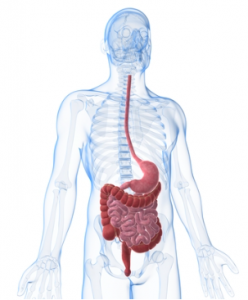 may lack the supply of digestive enzymes needed to process large amounts of food. This is especially the case with “dense” foods such as whey: in fact, using more than one scoop at a time (25-30g of protein) has been known to cause abdominal pain and bloating for some whey users. Whey may also trigger abdominal pain, gas, and diarrhea in those who are lactose intolerant, and overuse of whey (and other high protein foods) at the expense of high fiber foods may lead to constipation.
may lack the supply of digestive enzymes needed to process large amounts of food. This is especially the case with “dense” foods such as whey: in fact, using more than one scoop at a time (25-30g of protein) has been known to cause abdominal pain and bloating for some whey users. Whey may also trigger abdominal pain, gas, and diarrhea in those who are lactose intolerant, and overuse of whey (and other high protein foods) at the expense of high fiber foods may lead to constipation.
Potential for allergies
While not backed by any hard data, it has been anecdotally voiced that whey may trigger allergies in some people. These reports seems to indicate that regular long-term consumption may play a role.
Which Whey To Go?
Whereas other protein supplements may lack certain components, rendering them far from perfect (soy, for example, lacks the amino methionine and thus cannot be considered a complete protein source), whey, whether concentrate, isolate, or hydrolysate, is complete in every regard. Whey concentrate (29–89% protein by weight) is a basic, cost-effective supplemental protein. Though inferior to the isolates in some regards, whey protein concentrate could be considered more of a whole food given its higher ratios of milk fat and lactose (milk sugar), making it a slightly more effective weight gainer in its own right.
Whey isolate (90%+ protein by weight), is a superior source of pure protein compared to whey protein concentrate. Whey isolate begins its life as whey concentrate; processed through cross flow, ion exchange, or cold filtration (or 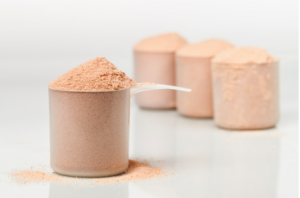 another filtration method) the fat and lactose is removed to provide a highly concentrated form of whey protein. Although the need for higher processing makes the isolates more expensive, they do tend to promote greater muscle gains.
another filtration method) the fat and lactose is removed to provide a highly concentrated form of whey protein. Although the need for higher processing makes the isolates more expensive, they do tend to promote greater muscle gains.
Enzymatically predigested to give it the highest rate of digestion of all whey protein types, whey hydrolysate is thought to be the gold standard against which other protein products are measured. The body normally hydrolyses protein in the gut before it can be absorbed, with whey hydrolysate this tedious process is circumvented. Besides being rapidly absorbed into muscle tissue hydrolysate also activates the glucose transporter GLUT4 in muscle cells to promote greater muscle glycogen uptake.
When to take whey
Provided its consumption does not provide an overabundance of calories, and our overall daily protein intake does not exceed desirable levels (any excess, when habitually consumed, may strain the kidneys in those susceptible to kidney disease, or those with a preexisting condition and, at best, be wasteful), whey protein may be used at any time of the day. With meals, between meals, and in particular post-training (ideally with creatine, additional glutamine, and a simple carbohydrate), whey protein is a convenient way to maximize muscle protein synthesis and spark growth.
In Conclusion
For our body to respond optimally to training, we must supply it with the right raw materials to encourage muscle protein synthesis. To stimulate a maximum amount of muscle growth, we must also ensure our body is as healthy as possible. Our muscles are likely to grow faster when our immune function is high and we are mentally and physically healthy. Whey protein, in particular the isolates, are a superior way to keep our muscle cells saturated with amino acids (both essential and nonessential). Among its many benefits, the regular consumption of whey has been shown to promote faster recovery between workouts, speed healing, boost the immune system, and prevent age associated muscle wasting. It is the most popular muscle building supplement on today’s market for a reason, because it works!
References
Adamik, B., Walszczyk, A. (1996): [Lactoferrin: its role in defence against infection and immunotropic properties.] Postepy Higieny Medycyny Doswiadczalnej 50:33-41.
Anthony, J., C. Anthony, T.,G. Kimball, S., R. & Jefferson, L., S. Signaling pathways involved in translational control of protein synthesis in skeletal muscle by leucine. J Nutr. 2001 ; 131: 856S?860S.
Barzel, U. S., Massey, L. K. Excess dietary protein can adversely affect bone. J Nutr. 1998; 128: 1051-1053.
Bounous, G., Baruchel, S., Falutz, J., Gold, P. Whey proteins as a food supplement in HIV-seropositive individuals”. Clin Invest Med. 1993 Jun;16(3):204-9.
Brink, W. New Longevity Benefits of Whey Protein. Life Extension Magazine. [Online] http://www.lef.org/Magazine/2013/9/New-Longevity-Benefits-of-Whey-Protein/Page-01 Retrieved on 18.11.15
Boirie, Y., Dangin, M., Gachon, P., Vasson, M.,P. Maubois, J.,L. Beaufrere, B. Slow and fast dietary proteins differently modulate postprandial protein accretion. Proc Nat Acad Sci. 1997; 94: 14930-14935.
Burke, D. G., Chilibeck, P. D., Davison, K. S., Candow, D. G., Farthing, J. & Smith Palmer, T.”The Effect of Whey Protein Supplementation With or Without Creatine Monohydrate Combined With Resistance Training on Lean Tissue Mass and Muscle Strength”. International Journal of Sport Nutrition and Exercise Metabolism. 2011, 11, 349-364.
Cox, L. What is Whey Protein? Live Science. [Online] http://www.livescience.com/45120-whey-protein-supplements.html Retrieved on 18.11.14
Cree, M., G. et al. (2004). Ingestion of Casein and Whey Proteins Results in Muscle Anabolism after Resistance Exercise. Medicine & Science in Sports & Exercise. Vol 36, Issue 12:2073-2081.
Cribb, P. J., Williams, A. D., Carey, M. F., and Hayes, A. “The Effect of Whey Isolate and Resistance Training on Strength, Body Composition, and Plasma Glutamine” International Journal of Sport Nutrition and Exercise Metabolism. 2006, 16, 494-509.
Diabetes in Control. Whey Protein Helps to Fight Obesity and Type 2 Diabetes [Online] http://www.diabetesincontrol.com/articles/diabetes-news/13600-whey-protein-helps-to-fight-obesity-and-type-2-diabetes Retrieved on 18.11.14
Fox, P. F., & Flynn, A. F. (1992) In Advanced Dairy Chemistry Vol. I. Proteins. (Larson, B.L. ed.), pp. 255-281. Elsevier Applied Science, London and New York.
Ha, E. Zemel, M. B. Functional properties of whey, whey components, and essential amino acids: mechanisms underlying health benefits for active people (review). J Nutr Biochem 2003;14:251-258.
Heilbronn, L., K. de Jonge, L., Frisard, M., I. et al. Effect of 6-month calorie restriction on biomarkers of longevity, metabolic adaptation, and oxidative stress in overweight individuals: A randomized controlled trial. JAMA. 2006;295:1539-48.
Ingram, D.,K. Roth, G., S. Glycolytic inhibition as a strategy for developing calorie restriction mimetics. Exp Gerontol. 2011;46:148-54.
Koopman, R., Verdijk, L., Manders, R., J. et al. Co-ingestion of protein and leucine stimulates muscle protein synthesis rates to the same extent in young and elderly lean men. Am J Clin Nutr. 2006 Sep;84(3):623-32.
Kinsella, J. E., & Whitehead, D. M. (1989) Proteins in whey: Chemical, physical and functional properties. Adv. Food Nutr. Res. 33:343-438.
Krissansen, G., W. Emerging health properties of whey proteins and their clinical implications. J Am Coll Nutr. Dec. 2007;26(6):713S-23S.
Kent, K., D. Harper, W., J. Bomser, J., A. Effect of whey protein isolate on intracellular glutathione and oxidant-induced cell death in human prostate epithelial cells. Toxicol In Vitro. 2003 Feb;17(1):27-33.
Lemon, P. W. Is increased dietary protein necessary or beneficial for individuals with a physically active lifestyle? Nutr Rev. 1996; 54: S169-S175.
Nutrition Express. Remarkable Whey Protein. [Online] http://www.nutritionexpress.com/article+index/protein/whey+protein/showarticle.aspx?id=307 Retrieved on 18.11.14
Sánchez, L., Calvo, M., Brock, J., H. (1992). “Biological role of lactoferrin”. Arch. Dis. Child. 67 (5): 657–61.)
Tsuda, H. Sekine, K. Ushida, Y, et al. Milk and dairy products in cancer prevention: focus on bovine lactoferrin. Mutat Res2000;462:227-233.
Yalçin, A., S. Emerging therapeutic potential of whey proteins and peptides. Curr Pharm Des. 2006;12(13):1637-43.
Zemel, M., D. Shi, H., Greer, B., DiRienzo, D., Zemel, P., C. Regulation of adiposity by dietary calcium. FASEB J. 2000; 14: 1132-1138.
Matsumoto, H. Shimokawa, Y. Ushida, Y. Toida, T. Hayasawa, H. New biological function of bovine alpha-lactalbumin: protective effect against ethanol- and stress-induced gastric mucosal injury in rats. Biosci Biotechnol Biochem. 2001 May; 61(5): 1104-1111.
Morato, PN. Lollo, PCB. Moura, CS. Batista, TM. Camargo, RL. Carneiro, EM. Amaya-Farfan, J. Whey Protein Hydrolysate Increases Translocation of GLUT-4 to the Plasma Membrane Independent of Insulin in Wistar Rats. PLOS ONE. 2013 Aug;
Tina Akhavan, Bohdan L Luhovyy, Peter H Brown, Clara E Cho, and G Harvey Anderson. Effect of premeal consumption of whey protein and its hydrolysate on food intake and postmeal glycemia and insulin responses in young adults. Am J Clin Nutr. April 2010 vol. 91 no. 4 966-975